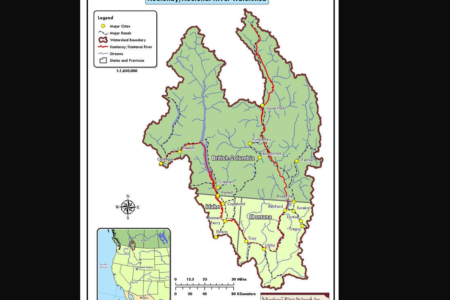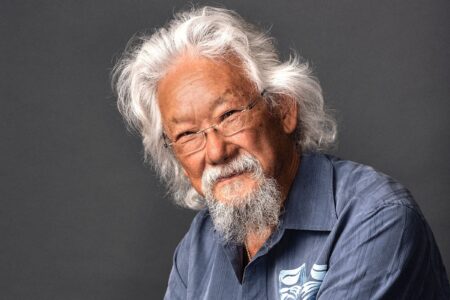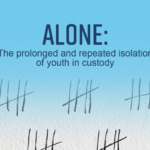Resorting to Tourism: Is Kellogg, Idaho Rossland's Future?
Acting on a set of free lift tickets my girlfriend picked up as a Christmas staff party prize we packed up skis, snowboards, food and a dog into the Jeep and headed 350km south and east for a mini-vacation at Silver Mountain in Kellogg Idaho. The resort is only a short three hour drive away; we didn’t realize until arriving that somewhere along the route we seemed to have crossed dimensions into a town that could very easily be a future version of Rossland.
Spending two days and two nights lapping up some deep Idaho panhandle powder (arguably a much better product than the potatoes) and immersing ourselves into both the local and tourist culture of Kellogg, we came home with a whole new impression of what Rossland is, what we love about it, and what it could potentially become.
Researching our destination before heading out and reading up on the history and culture of Kellogg (no relation to the cereal), it was as if I was reading the history of Rossland with slight twists at each turn. Founded in the 1890s quite literally by the actions of a jackass that wandered away from Mr. Kellogg himself only to be found munching on some grass atop Silver Mountain next to an outcropping of galena (iron ore), Kellogg would go on to become the largest silver mine in the world.
The mining boom quickly followed, growing the town to around 8,000 fine folks with the addition of a smelter operation in a town called Smelterville just down the road. The mining men, adapting to the cold and snowy north Idaho climate, eventually set up a ski lift on Wardner Peak, three ridges and valleys south of town. They named it the Jackass Ski Bowl and outfitted it with a 1960s vintage double chairlift that still operates to this day. Sound familiar?
For 90 years life was rich and prosperous for the mountain town. It had a beautiful heritage uptown district some five or six blocks long with turn of the century buildings full of shops and restaurants lining the city’s main street. Then the 80s arrived and Kellogg began to face many of the same issues that Rossland and Trail are either facing now or which potentially loom in our futures. The EPA (Environmental Protection Agency) was getting tough on the smelter for its less than stellar environmental record, and a combination of dwindling mine production, low commodity prices, growing environmental regulations and a smelting/mining company that (due to union wages on top of the other issues) could no longer make a go of it. The smelting company sold out to a new company in an effort to avoid bankruptcy and after a few years the new company went under as well, this time for good.
Being a one horse (or jackass) town with one large employer providing most of the well-paying jobs and over 75% of the city’s tax base, the smelter closure in the early 80s hit Kellogg hard. In a year over 2,500 jobs were lost and the city’s population fell from around 8,000 to 2,400. House values plummeted; no one could sell their home, and many just left their homes vacant and walked away. The once vibrant downtown core emptied out and old heritage buildings began to crumble.
“We had to figure out what to do to recover the town because the mining companies basically paid about three quarters of our taxes in the city which allowed us to provide pretty good services so we had a real dilemma on our hands,” explained Kellogg Mayor Mac Pooler. “I was born and raised in Kellogg and we were always told that Bunker Hill (The mining and smelting company) would run forever and well… that proved to be wrong and we were not ready for it.”
In an effort to rebuild the economic foundations of the town, the local governments went into planning mode to see just what could be done to keep Kellogg afloat.
“We had a ski hill that belonged to the city through the years and we sat down and brainstormed what we need to do to keep the city alive and the only thing we had really was a ski hill and the potential for tourism so we [the city] tried running it ourselves for a few years,” remembered Pooler.
Seeing tourism as the saviour of their town, the local government proceeded with a study into building a gondola which would run from town up to the base of an expanded ski area. The resulting gondola would become the world’s longest single stage gondola and run for eight miles up and over two ridgelines, up a total of 3,200 vertical feet to a new mountain top lodge called the Mountain Haus. This innovation saved skiers from having to make an at times treacherous drive up a winding access road.
“The gondola was put in by a private company but the city passed a two million dollar bond that in a referendum passed by 87 percent which was kind of amazing because with the unemployment rate at the time it wasn’t a good time to be spending public money… but people believed in it and that’s really the only thing that we had as a town and we got federal money and another ten million or so for the gondola and a new lodge up top and went for it” said Pooler.
The city, not being in a position to properly run a ski resort, sold out to a private company from out of town to take over the ski area and build it into the economic driver they hoped for. Speaking to this reporter, Silver Mountain’s marketing manager John Williams noted that a key mistake had been made in the initial development of the gondola that caused it to not have the desired effect on revitalizing the town. As part of the gondola development, two massive paved parking lots were constructed at the base which was located just off of the interstate about a kilometre from the historic downtown area. “If they could do it again they should have built the gondola station closer to the downtown area when they first put it in. What happened then was people would just come off the interstate hop on the gondola, ski all day and then hop back on the interstate and drive home. Many people wouldn’t even know the downtown area was there,” said Williams.
Walking through Kellogg’s heritage downtown area, things look remarkably similar to Rossland in terms of size, scale and the style of the buildings. Except for one major difference. In an hour of strolling around the area, we didn’t come across a single person on foot and at least half of the old buildings were shuttered up, closed, or run down to the point of being unusable and unsightly. While a number of ‘fix up’ and downtown stimulus initiatives appeared to have been launched, including a stylish brick tiling of the town’s snowflake and flower emblem, only a few coffee shops and small boutique shops seemed to have put money into the district and were trying to make a go of it. With a few new small businesses in the old buildings, the uptown district appeared to be in the beginning stages of building itself out of the dark days and starting to realize the great potential it contains.
JELD-WEN Windows and Doors, a company out of Oregon, bought the resort in the mid-90s and took on the task of building the community ski hill into a full on resort and real estate development. If the gondola hadn’t fully achieved the goals the city desired then they were moving on to the next step of resort residential development and a golf course/residential development at the base of the mountain.
JELD-WEN seems to have struck a chord in Kellogg. They made good on their promises to the town, investing over 50 million dollars into the area. Freshly opened in the past three years, one of the parking lots has been converted into a mini-Whistler pedestrian resort village with 850 condo units (for size comparison whistler has over 50,000 beds), a number of shops and restaurants, and the centre piece of the development–a massive indoor water park.
The water park features a football field-sized indoor playground of waterslides, a very popular standing surf wave, lazy river and a whole host of water games, attractions and food services. It has been the main catalyst for change and growth since its opening in the spring of 2008. Not typically something you’d find associated with a ski resort, anyone with kids would have a blast in the facility, which was built purely as a draw to sell hotel nights on the spring break weekend. On this particular spring break weekend the water park for the first time since opening had more guests than the ski hill.
While super fun as a vacation spot with beautiful accommodations, fantastic skiing on a nearly empty ski hill with loads of awesome terrain and some of the friendliest and helpful staff you’ll ever find, there still seems to be a disconnect between the town and the new resort. Looking out the windows of the hotel, a very clear dividing line between resort and local town was evident. In ten steps you can walk from the gondola-in-gondola-out village to cracked up streets and run down single family homes.
Things are, however, improving with a side focus at the resort on keeping guests longer and getting them to explore. “We’re at a point right now where our average guest stay is two nights, so they don’t really leave the resort much and get into town,” explained Williams. “ We’re working on getting that stay a bit longer and when that happens I think you’ll see more people wandering into town, and that should help things out a bit.”
Chatting candidly with the mayor of Kellogg, I was curious to find out if, twenty years into the tourism experiment, things had worked out well for them, or if they would have changed things knowing what they know now.
Pointing out the progression from how bad things had gotten after the smelter shutdown to the current slow rebuilding and reviving of the town, Mayor Pooler largely considered the project a success, although he did admit there had been some bumps along the way.
“The problem with tourism is that it’s based on the economics of the country,” explained Pooler.
“We found out after 9/11 and when gas prices went up that people didn’t travel like they normally did. So you’ve got other things you need to look at like small businesses in town like we are working at now. The big issue was being designated as a superfund site (EPA fund to clean up the toxic smelter site using public money). We had major issues with developers and bankers who weren’t real keen to come in and make investments but we worked hard to get that cleaned up and straightened out and now we have a clean city again, ready to move forward. The people in this community are hard working and they believed in what we were trying to do and I think we’ve done a good job at it.”
Noting that the old uptown core could still use a lot of work and doesn’t seem to have rebounded with the tourism growth in town I asked about that area.
“The problem you have in trying to develop the old uptown area is that those buildings were basically built in the early 1900s, and as a buyer if you come in to renovate them you have to bring everything up to current code: wiring plumbing, health systems. So there’s a lot less costs to build new strip style development along the interstate,” said Pooler. “That’s an area we’re working hard with the chamber on and it’s a long process that’s not going to heal itself right away.”
Comparing Kellogg’s reaction to the changes it’s been through to Rossland’s reactions to new developments at Red, I was curious as to how receptive the town has been to the tourism boom and new resort development.
“Well you see we have a lot of what you call old families that have been here a long time. They want the development but they are real hesitant about not wanting a condo next door so you have to be really careful. We were in trouble in a big way when the smelter shut down though and people wanted to get behind anything that would rebuild the economic base of the town so we could still afford to offer the services we had,” said Pooler.
For anyone who’s watched the politics, backlash and rumours that have run rampant in Rossland over the past couple of years around the proposed golf course and residential development, Mayor Pooler’s advice on development will really hit home. The crux of what he said was that the key to helping to turn things around was communication: communication between the city and the developers; communication between the city and the people; and communication between the developers and the people.
“The whole issue number one is that you’ve got to be fair and upfront and get the information out to your residents because they are the ones ultimately who are going to live with whatever it is that you change. Number two is get your prior planning like land use zoning and planning in place because once the developers come in, if you have everything done upfront there is a lot more of a comfort level with the developers and the residents that they know what to expect,” Pooler explained passionately.
“What will kill you is rumours and uncertainty. You’ve got to keep the information out in front of the people, or rumours will kill you and tear the town apart.”
The Kellogg city council achieved this by taking the time after the smelter shut down to not jump into bed with any old plan. They instead took the time to go through an extensive planning process and get everything in place so that when the developers came knocking they were prepared.
“If you do your homework before you get into it and not while you are doing it you’ll be much better served, because you avoid the problem of gut reactions,” explained Pooler. “We had that timeframe after the mine and smelter shut down before things started to pick up again to really look at our zoning, our comprehensive community plan, connection fees for sewer and water and all of that. You really need to do that homework before the development starts. Good developers want to come in and know exactly what they are facing up front rather than start a project and have the rules changed on them mid-stream. We did have some time to do all of that preparation to hire a city planner in the down time when things were going bad and the city was ready to hang me, but we were able to put these things in place to be ready when the development came back calling.”
The next phase in Kellogg is the construction of a new mountainside golf course and residential development and the construction of 4,100 units that have been approved by the city around the valley and are expected to begin construction once the economy begins to turn around.
Side benefits of the resort development have included improvements to local amenities such as the rail yard and rail lines that have been constructed into a linear park hundreds of kilometres long that links up areas from as far away as Missoula, Montana through to Spokane, Washington and beyond with a green belt and trails linking park to park.
The good news in Kellogg is that with the new jobs brought to town from tourism, the city has stabilized and has begun to slowly grow again with its population now sitting in the mid 3,000 range.
The ski hill and resort are steadily growing their business but the big recovery and saviour of the town has never fully been realized in the way residents first imagined it might. While the city is certainly much greener and cleaner (with the old smelter site now appearing only as a large meadow equal to the size of the current town site) many of the lost jobs have never been replaced.
Lessons learned on the trip are first and foremost that, regardless of the size, shape and nature of any development or plans in general for any city’s future, co-operation and communication between the government, the people and all stakeholders is the key to community engagement and success.
While a water park on the Emcon lands isn’t likely the right fit for Rossland, a gondola to and from town, if integrated with the downtown core and used as much for local transportation as opposed to solely tourism development, could potentially work. As was noted by several locals that we talked to while in town, however, basing a town’s future solely on tourism is as much a boom and bust endeavour as mining was in the past; a balance, people felt, must be reached between development for tourists as well as development and revitalization for residents.
We are lucky in Rossland in that we are not yet and may not ever be in the position of having our core industry (Teck or Red) leave town, forcing us to completely rebuild. Another message passed on from Kellogg’s mayor however is to plan now: begin diversifying the economy now and don’t wait until disaster hits. Our strategic sustainability plan and official community plan seem to show that we are well on our way in that respect. Coupling our planning to a much-needed improvement in communications, as suggested by Mayor Pooler, should put Rossland in a good position to meet any future challenges.
To get a better view of a possible future scenario for Rossland and enjoy some incredible skiing on a mountain similar to Red with equally few people, Silver Mountain and Kellogg is a destination worth checking out. While you may not be able to people watch on the main street, you can at least laugh, as we did, while lapping up powder turn after untracked powder turn high above the clouds with the other tourists splash about in the water park, not knowing what they are missing.
One local we ran into in a bar at the base of the gondola noted, “I’m all for the resort development down here in the valley. It just means less people up top to share the snow with.”























